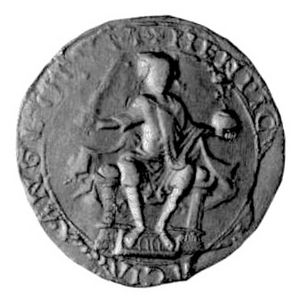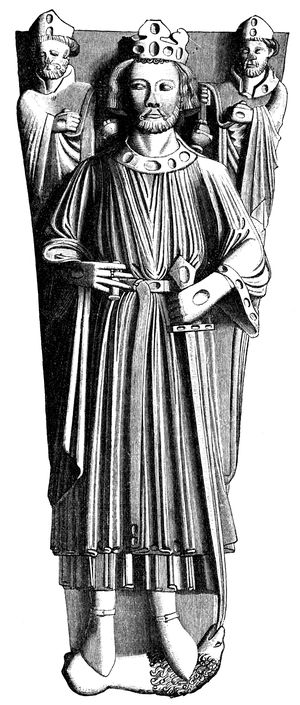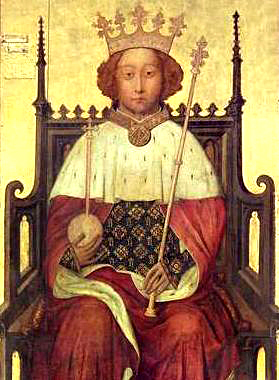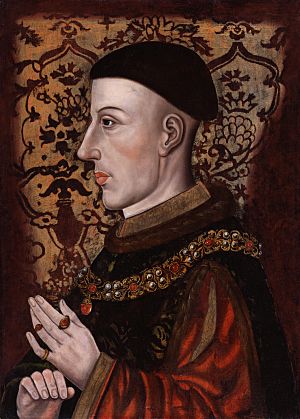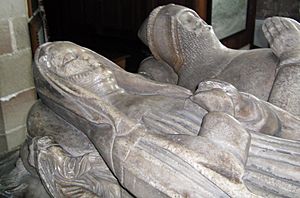Lapley Priory facts for kids
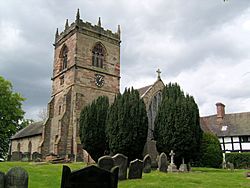
All Saints' Church, Lapley. Much of the building goes back to the 12th century, around the time the priory was established. The priory stood on the site of the timber-framed manor house, behind the church.
|
|
| Monastery information | |
|---|---|
| Order | Benedictine |
| Established | Land donated circa 1061. Monks present before 1086. Date of priory unknown, but by mid-12th century. |
| Disestablished | 1415 |
| Mother house | Abbey of Saint-Remi, Reims, Northern France. |
| Dedicated to | St Peter |
| Diocese | Diocese of Coventry and Lichfield |
| Controlled churches | All Saints Church, Lapley |
| People | |
| Founder(s) | Land donated by Ælfgar, Earl of Mercia |
| Site | |
| Location | Lapley, Staffordshire, United Kingdom |
| Coordinates | 52°42′50″N 2°11′24″W / 52.714°N 2.190°W |
| Other information | Lapley Manor is a private residence. All Saints Church is still in use for regular worship. |
|
Listed Building – Grade I
|
|
| Official name: Church of All Saints | |
| Designated: | 19 March 1962 |
| Reference #: | 1374057 |
|
Listed Building – Grade II
|
|
| Official name: Lapley Manor | |
| Designated: | 16 May 1953 |
| Reference #: | 1178284 |
Lapley Priory was a small priory (a type of monastery) in Staffordshire, England. It was founded around the time of the Norman Conquest. This priory was an "alien priory", which means it was a branch of a larger Benedictine monastery in another country. Lapley Priory belonged to the Abbey of Saint-Remi in Reims, France.
Over the years, the priory faced many ups and downs, especially when England and France were at war. It was finally closed down in 1415. Its lands and money were then given to a church in Tong, Shropshire.
Contents
How Lapley Priory Began
The story of Lapley Priory starts with gifts of land just before the Norman Conquest in 1066.
A Son's Last Wish
In 1061, a young man named Burchard, son of Ælfgar, Earl of Mercia, traveled with Archbishop Ealdred. While in Reims, France, Burchard became very ill. He asked to be buried at the Benedictine Abbey of Saint-Remi there.
To honor his son's wish, Earl Ælfgar gave five pieces of land to the Abbey of Saint-Remi. These lands were in Staffordshire (Lapley, Hamstall Ridware, Meaford, and Marston) and Shropshire (Silvington). The main goal was to pay for two priests to say Mass every day at the Abbey in France, praying for Burchard's soul.
Early Days and Domesday Book
The Abbey of Saint-Remi owned these lands even before William the Conqueror became king. This was recorded in the Domesday Book in 1086, a big survey of England's lands. The Domesday Book mentioned Lapley and Marston, saying the Church of St. Rémy held them. It also noted that "two of St. Rémy's men" lived at Marston. This suggests that a few monks from the French abbey were already living in Staffordshire by 1086.
It's not clear exactly when a full priory was built at Lapley. But by the mid-1100s, it was definitely up and running. Letters from the abbot of St. Rémy mention "brothers at Lapley" and even the "prior of Lapley."
Lands and Money
The priory's main job was to manage the lands given to it by Earl Ælfgar. These lands helped support the monks and sent money back to the main abbey in France.
Royal Support and Challenges
King Henry I (1100–1135) confirmed the Abbey's ownership of its lands. He also said the monks didn't have to attend local courts. This was important because attending courts could involve legal disputes or even violence, which monks tried to avoid.
Once, a monk named Godric had to go to the king to prove the priory's right to the church at Lapley. Someone else was trying to claim it! King Henry I ruled in favor of the priory. This showed that the priory had the right to choose the priest for the Lapley church. This right, called advowson, could be profitable, but it also meant the priory had to make sure the church was well-supported.
Managing the Estates
The monks directly managed the lands at Lapley and Marston. However, they often leased out the more distant estates, like Hamstall Ridware and Silvington, to other people. This sometimes led to problems, as the priory got involved in the disputes of the families who rented the land.
For example, the tenant at Hamstall Ridware had to perform a special service: acting as a marshal at the priory during Christmas. This was a type of rent called serjeanty. The priory also had rights like holding its own courts for its tenants and even setting up gallows for serious crimes.
Financial Troubles
The priory was supposed to send a lot of money to the Abbey in France each year. However, it often struggled financially. As an "alien house," it was frequently targeted by the English king during wars with France. The king would seize the priory's lands and money, or demand large payments to let the monks keep control.
In 1367, the priory managed to send a large sum of money (120 marks) to France. But this was unusual. The Hundred Years' War and the Black Death (a terrible plague) had made things very difficult. By 1379, the priory's total yearly income was only about £26.
Life at the Priory
Lapley Priory was dedicated to St Peter. It was located north of the local church, and both were surrounded by a moat.
The Monks and Their Leader
There were usually only a few monks at Lapley Priory, often just two or three. Most of them came from France.
The monks at Lapley didn't get to choose their own leader. The "prior" (the head of the priory) was chosen directly by the abbot in Reims, France. The local bishop would then officially approve the new prior. The abbot could also remove a prior if he wasn't doing a good job. Sometimes, priors had to travel to France to visit the main abbey, which could be risky if they didn't get the king's permission.
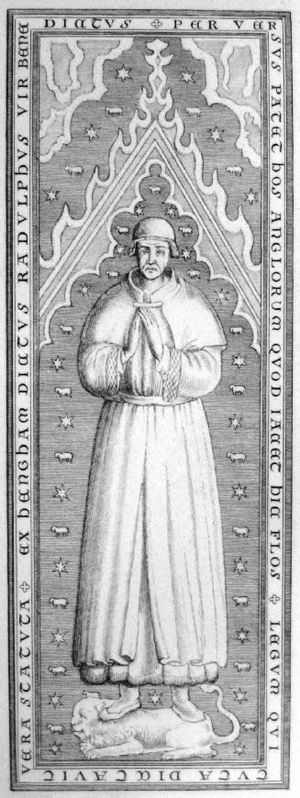
The small group of monks acted like the local lord of the manor. They managed the land and collected rents. They tried to avoid things that went against their Benedictine rules, like being involved in violence. For example, they were usually exempt from attending local courts where legal disputes, sometimes violent, were settled.
However, they did use the law when needed. In 1282, the prior was tricked by people pretending to be the king's officers, who stole goods from him. The chief judge of the King's Bench had to investigate!
Local Power and Disputes
The priory had the right to hold its own courts for its tenants, called "view of frankpledge". This meant they were responsible for law and order among their tenants. They even had the right to put up gallows for executions on their lands. They also had "free warren", which allowed them to hunt on their own land.
Sometimes, these rights led to arguments. In 1382, a tenant sued the prior, claiming his horse was illegally seized. The priory said it was because the tenant hadn't provided workers for the priory's land, as he was supposed to. The tenant argued it was to make him pay for the priory's court fees. A jury eventually sided with the tenant.
Leadership Battles
In the 1330s, the priory faced a big internal problem: two monks, Baldwin de Spynale and Gobert de Lapion, both claimed to be the prior. The abbot in France sent Gobert, but Baldwin was already in charge and got the local bishop to support him.
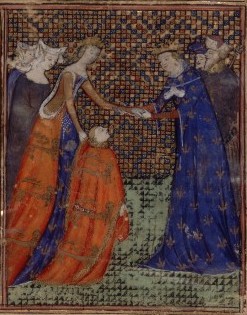
This fight led to raids on the priory, with livestock being stolen and documents taken. King Edward III even got involved, trying to sort out the mess. He saw it as a chance to benefit the Crown. This dispute made the priory very weak and open to the king's control.
Challenges and Closure
As an "alien priory," Lapley was always at risk when England was at war with France.
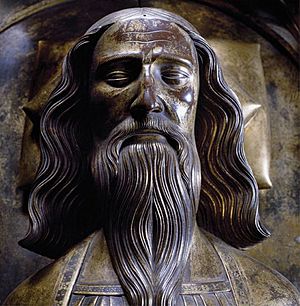
Seizures by the King
In 1204, after England lost land to France, King John seized many alien priories, including Lapley. The prior had to pay a large sum to get control back.
This happened again in 1324 when war broke out with France. The priory was only returned if it paid the king 55 marks each year. When Edward III became king in 1327, he promised to stop these payments, but this didn't last.
The Hundred Years' War and Decline
The Hundred Years' War, which started in 1337, led to many seizures of alien priories. Lapley was taken by the Crown immediately. The king used the leadership dispute between Baldwin and Gobert to his advantage, renting the priory back to them at different rates.
The priory's financial situation got worse. In 1342, the king had to investigate damage and waste at the priory. In 1354, Baldwin reported a big fire that had destroyed buildings and left the priory in a terrible state. The king had to forgive the priory's debts and reduce its rent. Queen Isabella, the king's mother, often helped Baldwin get better terms.
After a peace treaty in 1360, the priories were returned to their owners without rent. But when war started again, Lapley was seized once more. In 1384, King Richard II gave the priory to one of his knights, Richard de Hampton, for free. The prior had to lease it back from Hampton at a very high rent.
King Henry IV tried to give the alien priories back to their owners. But the English Parliament pushed him to reconsider. They wanted to know if the priories were truly independent. Lapley was clearly just a small branch of the French abbey, so it was taken by the king again in 1403.
Final Dissolution
Finally, King Henry V decided to close all alien priories in England. He was planning for war with France (like the famous Battle of Agincourt) and wanted to show himself as a strong English king. He promised that these closures would be permanent.
Lapley Priory was officially closed on June 15, 1415. All its lands and money were given to Tong College, a new church foundation nearby. This meant the end of Lapley Priory as a monastery.
What Happened Next
Even after it closed, Lapley's lands continued to be owned by Tong College. Tong College itself was later closed during the time of King Henry VIII and King Edward VI.
Eventually, the Lapley estate was sold to a judge named Robert Broke. It's believed that the current Lapley Manor house, built where the old priory stood, was built by the Broke family in the late 1500s. The church, which was part of the priory, survived and is still used today.
List of Priors
Here are some of the people who were in charge of Lapley Priory over the years:
- Godric (or Godwin) - Likely the prior around 1100, who defended the priory's rights to King Henry I.
- P. - A prior mentioned around 1162-1181, though not in a very positive way!
- Absalon - Sent as a possible replacement for P.
- Inganus - Prior around 1181 and 1205, who had to pay a fine to get the priory back after King John seized it.
- John - Presented as prior in 1233.
- Walcher - Mentioned in 1266.
- Reynold - Mentioned in 1297.
- Peter de Passiaco - Resigned in 1305.
- John de Tannione - Prior from 1305 to 1320.
- Gobert of Brabant - Prior from 1320 to 1322.
- John de Aceyo - Prior from 1322 to about 1328.
- Baldwin de Spynale - Likely prior from 1328, involved in the leadership dispute. He was the prior when the priory suffered a big fire in 1354.
- Gobert de Lapion - The rival prior in the 1330s dispute.
- Peter de Gennereyo - Became prior in 1362.
- Peter Romelot - Mentioned as prior in 1377. He might be the same person as Peter de Gennereyo.
- John Bally - Became prior in 1399 and was the last prior when the priory was closed in 1415.




